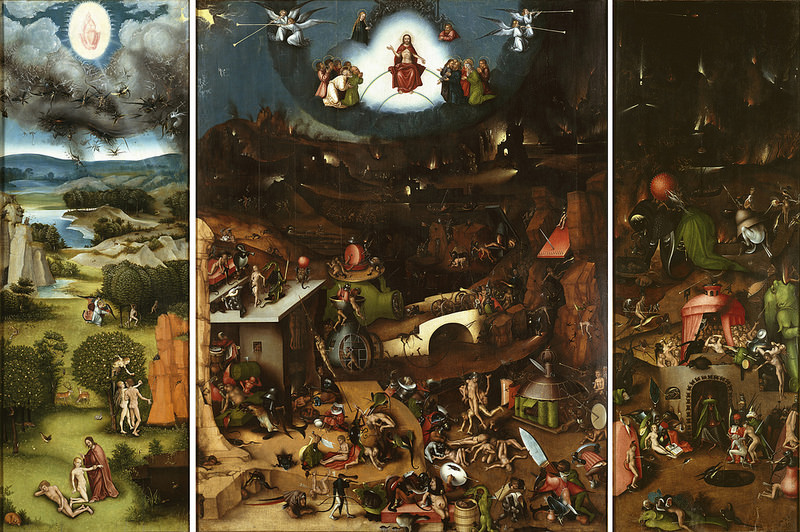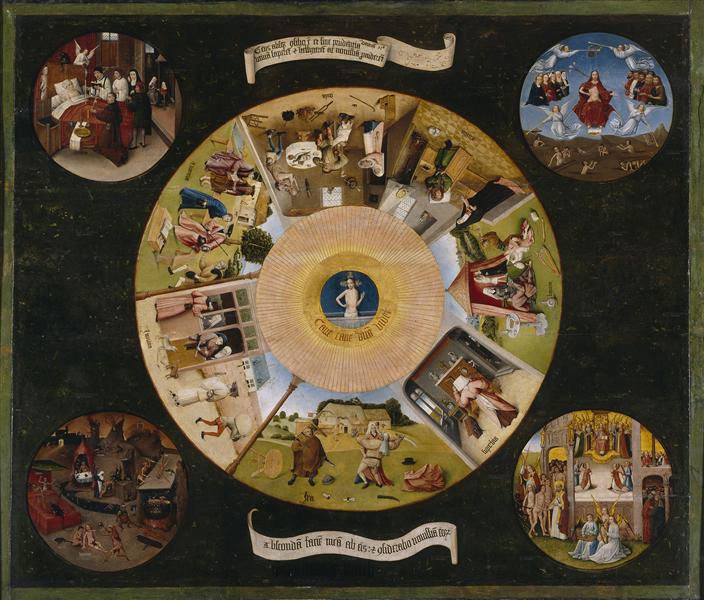Hieronymus Bosch
Hieronymus Bosch is one of the famous and revolutionary artists of the High Renaissance and was well known and highly appreciated during his lifetime and in the 16th century. His work also was collected by Philip II of Spain, who shared Bosch’s dark vision, often filled with bizarre and cruel images, depict a sinful world in which demons and weird creatures torment people.

Hieronymus Bosch was born in ‘s-Hertogenbosch, in North Brabant, the Netherlands and was named after his birthplace. History does not know about his life and the accurate dates of the paintings because his works were not documented, and he had no visible style change. What is known is that he gained many commissions to paint from abroad, and it is thought that he was taught to paint in the family workshop. In 1488 he joined the Brotherhood of Our Lady, a highly respected conservative religious group.
Many of his works developed and were inspired by medieval symbols, producing an unimaginable combination of satire, humour and folklore of the late Middle Ages. Bosch is distinguished from his contemporaries not only by his expression of anxiety and problems of human consciousness but also by using brushwork and the presence of his autonomous style, which separate him from the mainstream of Flemish art.

Bosch’s most famous and complex triptych is The Garden of Earthly Delights, probably painted after 1500. There are three different landscapes, where side panels illustrate the Creation of Man in Eden and Hell. The central panel shows numerous naked people, animals and substantial fantastic fruits, which is perhaps a condemnation of hedonism.
Hieronymus Bosch is an important figure of the late Renaissance who influenced many artists like Bugel and surrealists, including Salvador Dali, Joan Miro and Yves Tanguy.

Bosch is distinguished by his unrestrained imagination and bizarre shapes, which are fascinating to watch and study. Every detail appears before the viewer as a rather funny picture, but you can see a lot of meaning by looking closely, reflecting the sins, depravity and difficulties. That’s why I love Bosch’s paintings. His paintings are provocative, filled with satire and strikingly different from everything created by artists of that time.
REFERENCES:
“Bosch, Hieronymus (c. 1460–1516).” The Hutchinson Unabridged Encyclopedia with Atlas and Weather Guide, edited by Helicon, 2018. Credo Reference, https://ezproxy.capilanou.ca/login?url=https://search.credoreference.com/content/entry/heliconhe/bosch_hieronymus_c_1460_1516/0?institutionId=6884. Accessed 17 Oct. 2021.
“Bosch Hieronymus (c. 1450 – 1516).” A Biographical Dictionary of Artists, Andromeda, edited by Lawrence Gowing, Windmill Books (Andromeda International), 2nd edition, 1995. Credo Reference, https://ezproxy.capilanou.ca/login?url=https://search.credoreference.com/content/entry/andbda/bosch_hieronymus_c_1450_1516/0?institutionId=6884. Accessed 17 Oct. 2021.
“Bosch, Hieronymus (c. 1453 – 1516).” The Encyclopaedia of the Renaissance, edited by Thomas Goddard Bergin, and Jennifer Speake, Market House Books Ltd, 1st edition, 1987. Credo Reference, https://ezproxy.capilanou.ca/login?url=https://search.credoreference.com/content/entry/mheren/bosch_hieronymus_c_1453_1516/0?institutionId=6884. Accessed 17 Oct. 2021.
“Bosch, Hieronymus, also called van Aeken (c. 1450 – 1516).” The Thames & Hudson Dictionary of Art and Artists, edited by Herbert Edward Read, and Nikos Stangos, Thames & Hudson, 2nd edition, 1994. Credo Reference, https://ezproxy.capilanou.ca/login?url=https://search.credoreference.com/content/entry/thaa/bosch_hieronymus_also_called_van_aeken_c_1450_1516/0?institutionId=6884. Accessed 17 Oct. 2021.

October 21, 2021 at 10:05 pm
Liza,
Nice work on Bosch here! You have good information through your research and have added your own personal thoughts and feelings about the work which is what I’m looking for. Only thing is that you were to choose an artist from Baroque, Dutch Golden Age and Rococo, Neoclassicism, Romanticism for your second post. I’ll overlook it this time but refer back to the Blog Post brief to see what eras you should choose from for the remaining three posts. That said I’m giving you 2/2 for both of these.
Jeff
October 26, 2021 at 11:28 pm
Thanks for the feedback! I’ll take your comment into account and be more attentive next time